 |
2020 UPGRADES |  |
Everyone has to have a hobby. A creative outlet.
Some people restore automobiles. Some people carve sculptures.
I build computers.
Not just any computers. Enthusiast level computers.
Like the behemoth you see below.
An unholy triumph of form and function.
Those familiar with my work will recognize elements of this build from previous publications,
but much has been added
recently.
I have created a grotesque powerhouse of ridiculous proportions
while maintaining an elegant and simplistic environment in which to work and play.
Join me for a quick pictorial of my recent acquisitions and upgrades.
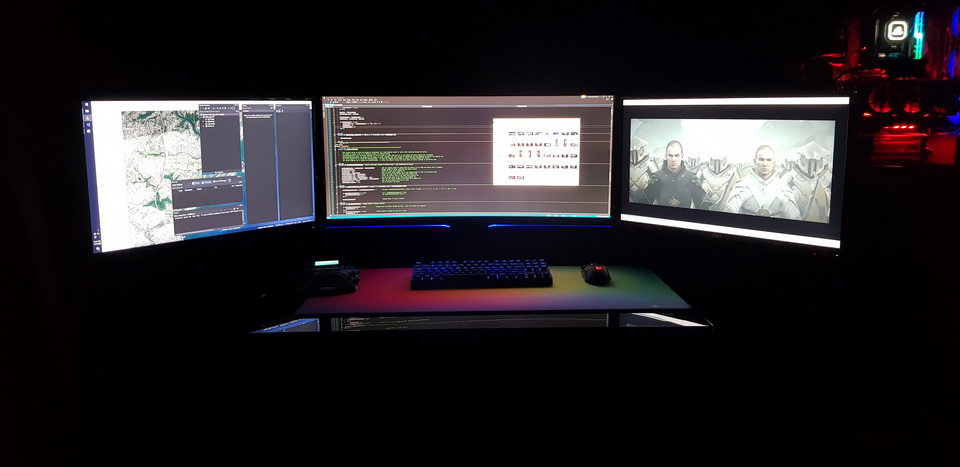 |
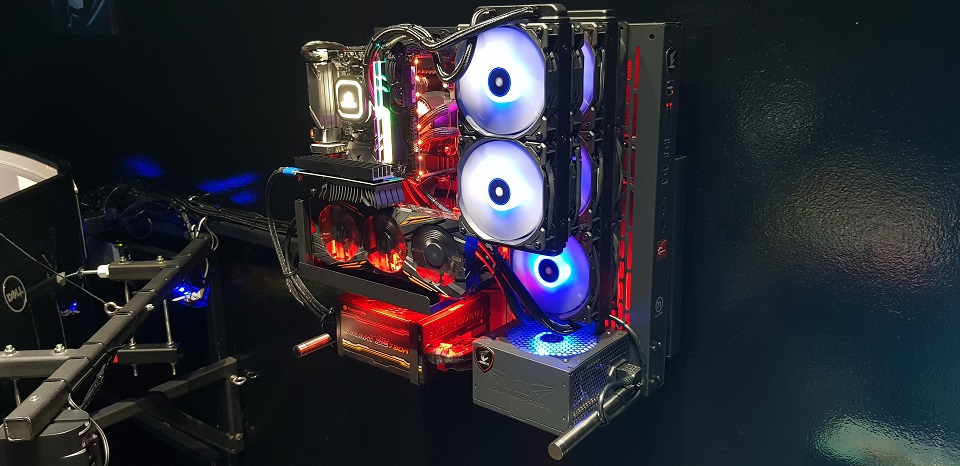 |
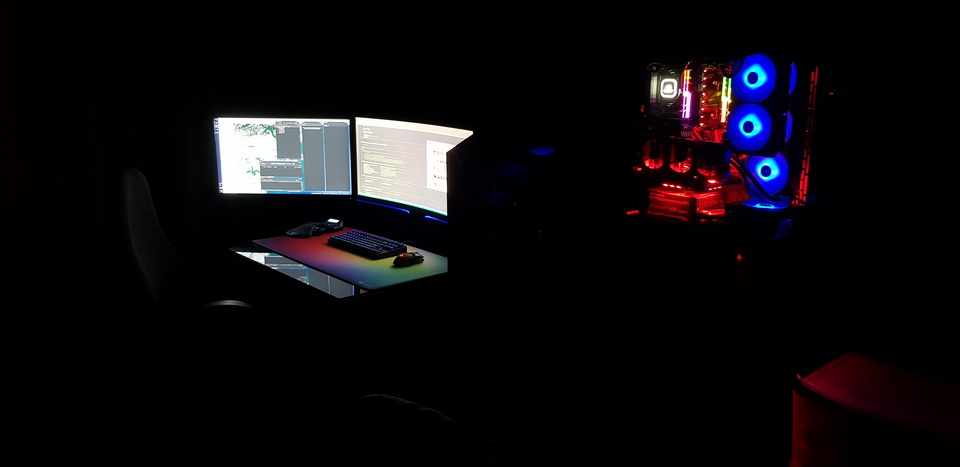 |
 |
The Build |  |
This build was not a single event but a series of upgrades taking place over a couple of months.
All with the intention of arriving at the finished product seen above.
Let’s start with the star of the show - the PC.
A few months ago I installed my Asus ROG board with my i7 and RX470 onto
this Thermaltake P3 chassis.
But the board was 4 years old and in desperate need up upgrading.
So after some industry research I decided to go the route that many have gone since AMD began to raise the bar on consumer class CPUs.
Additionally, even though I have been an Asus Rog fan for many years, I could not overlook the amazing motherboards released lately by Gigabyte - that being their AORUS range of premium motherboards.
When choosing a motherboard, one of the biggest considerations is the chipset.
The Chipset is really the heart of the motherboard (Not to be confused with the CPU).
The better the chipset, the more powerful and more feature packed your build becomes.
I held nothing back and purchased the best option available - the X570.
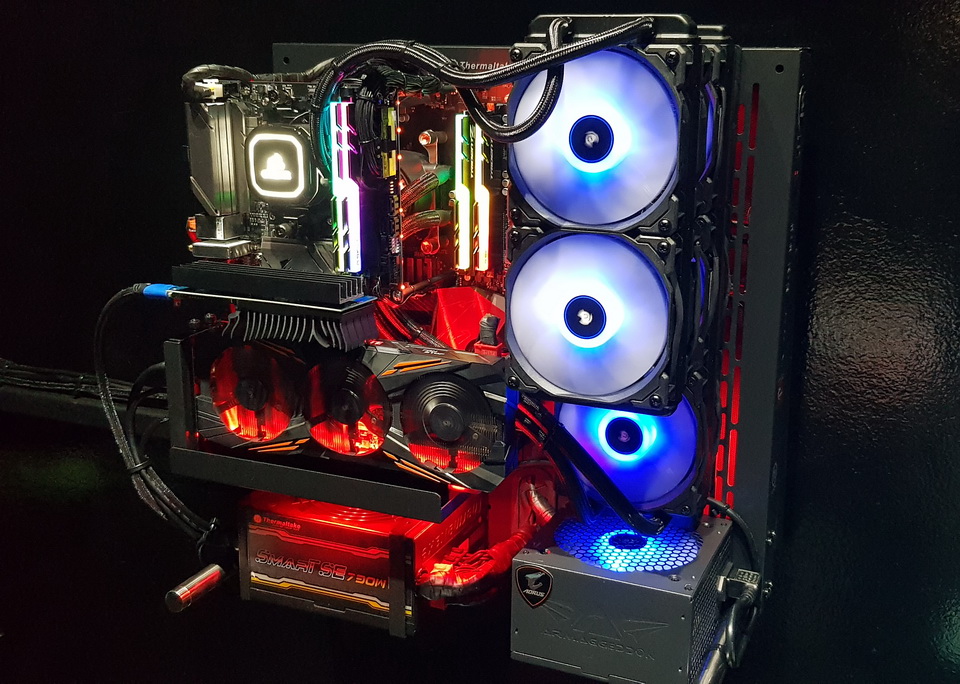 |
That was the start of the product that you see above.
Let's take a closer look.
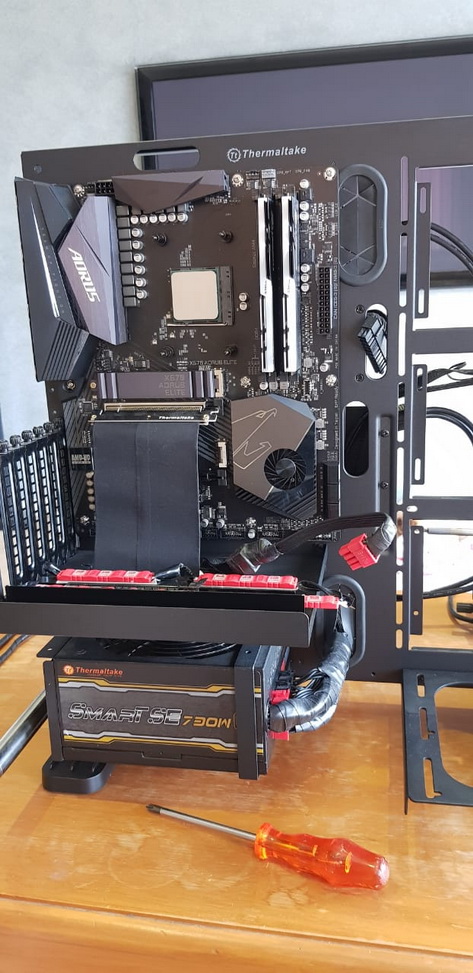 |
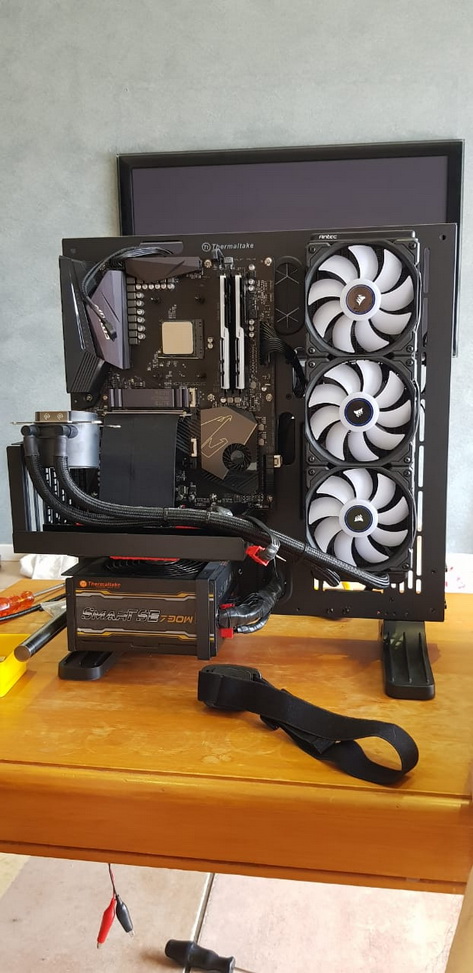 |
Firstly my Thermaltake Core P3 Chassis was stripped bare.
The Gigabyte Aorus X570 motherboard was fitted. A high end, feature packed board.
I chose GSkill Trident
Z RAM mainly because of the attractive RGB effects.
Next came the Antec 360 All-In-One water cooler for the CPU.
The CPU that you see on the board is the AMD Third Generation Ryzen 5 - 3600X.
It is a 6 core, 12 thread Processor clocking up to 4.4 GHz.
It also supports PCIe Gen 4 and many other new technologies.
 |
I then fitted my existing Gigabyte Nvidia Geforce GTX 1080.
Not the latest graphics card on the market but still powerful enough to belt through today's games.
I also added a series of red LEDs.
Hidden from view are the NVME and SSD drives providing a combined 1.5 Terabytes of high speed solid state storage.
That completes the behemoth of a PC which provides my primary source of computing power.
But I wasn't done yet...
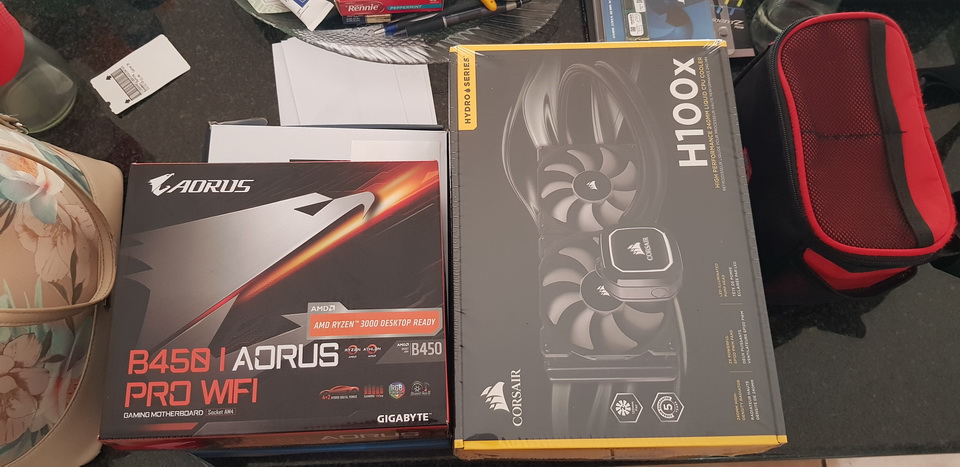 |
I felt that I needed more processing power for an ongoing software project of mine.
Power in the form of additional processor cores.
I had to choose between replacing my new processor with the Ryzen 7 3900X or
building another separate PC with an AMD Ryzen 3600 on it.
For numerous reasons I decided to go with the latter and build a second separate PC into my rig.
To make this possible I opted for a Mini ITX form factor motherboard.
Again I selected Gigabyte Auros, but this time with the B450 Chipset as it satisfied all my needs at a much lower price point.
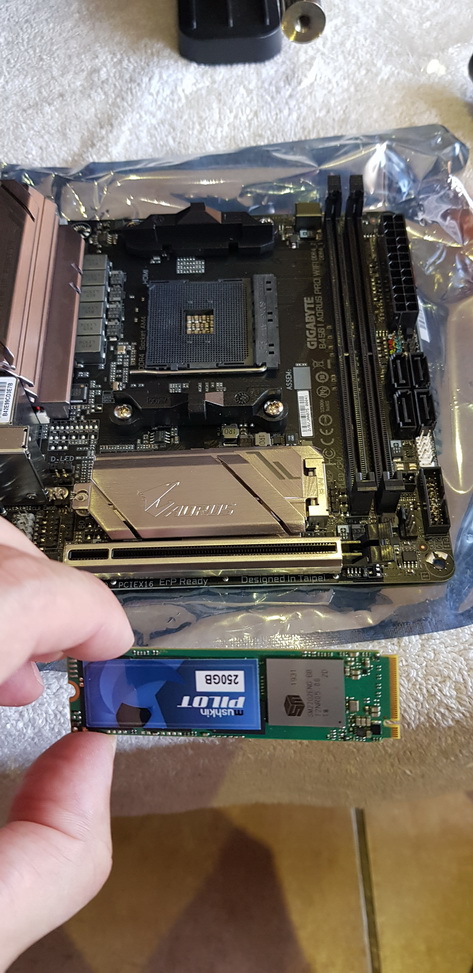 |
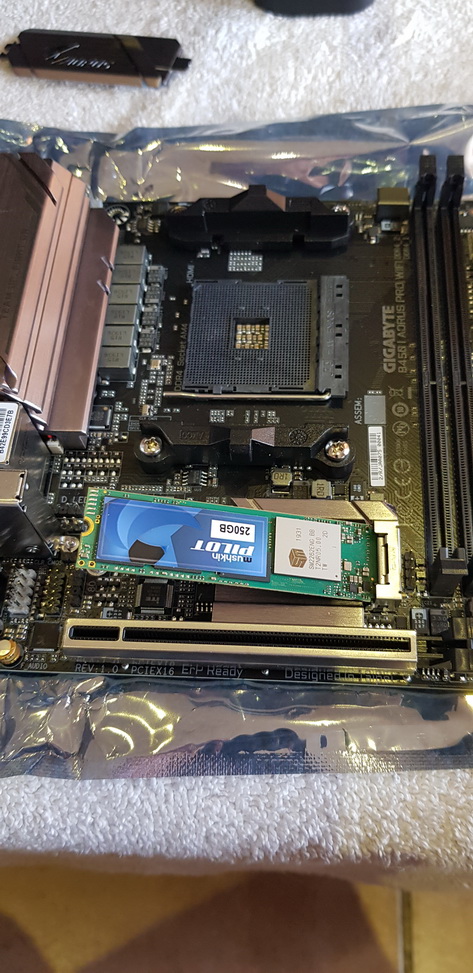 |
The Auros B450 is certainly one of the most attractive Mini ITX motherboards on the market at the moment.
For storage I opted for a Mushkin 250 Gig NVME drive.
Not the fastest on the market, but more than enough for this purpose built PC.
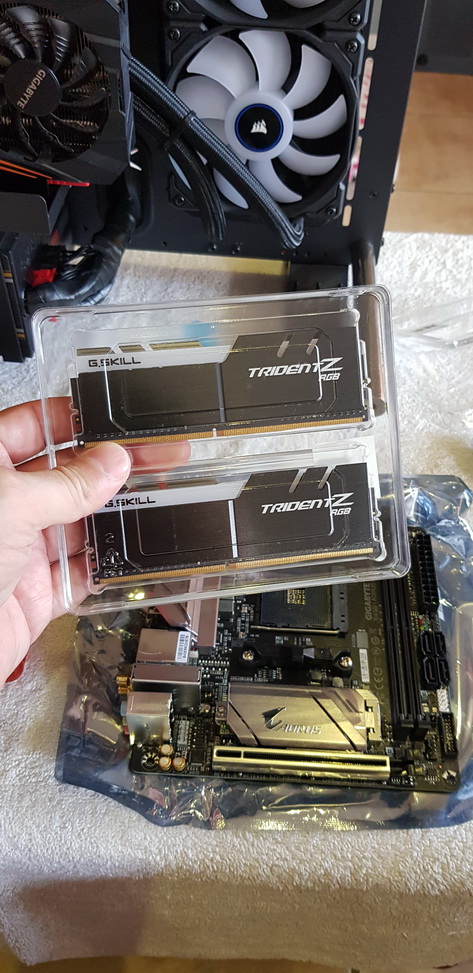 |
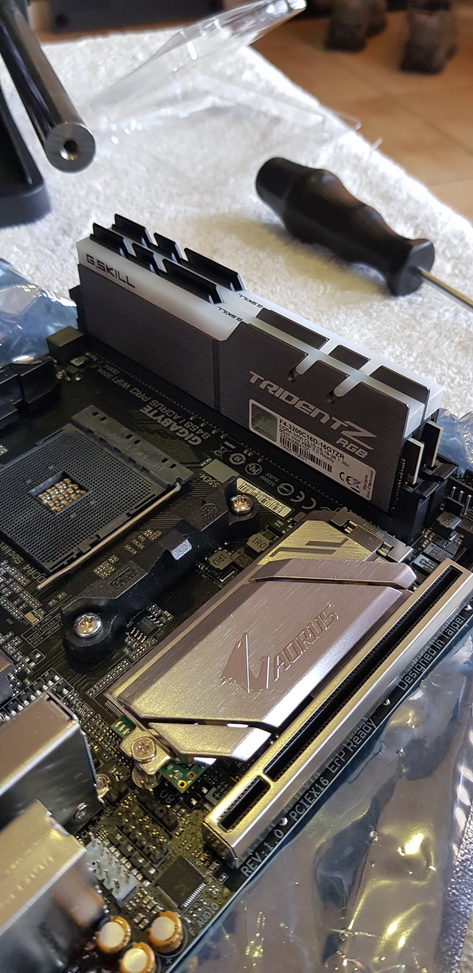 |
Again I selected the GSkill Trident Z RAM - mainly to match my existing RAM on my X570 board.
I have always loved the Mini ITX form factor. All the power in half the space.
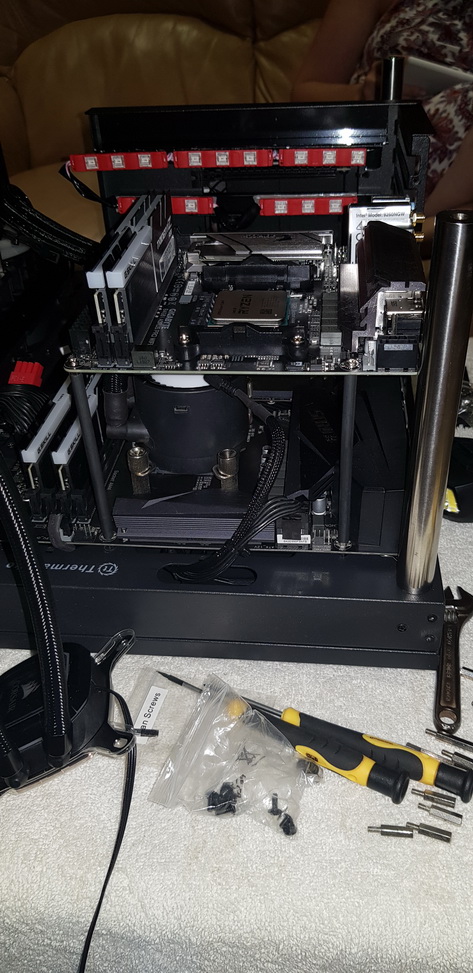 |
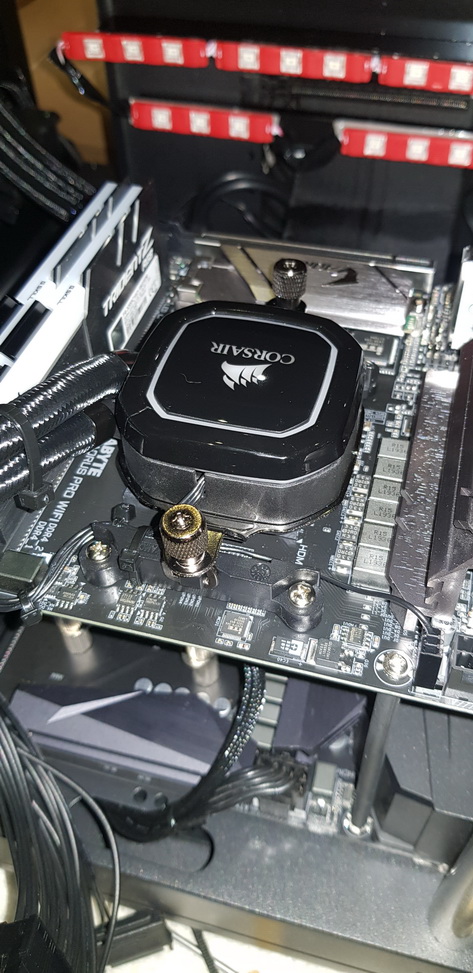 |
I installed another AMD Ryzen processor into this board. This time the Gen 3 Ryzen 5 3600.
A 6 Core, 12 Thread processor offering a clock speed of up to 4.2 GHz.
The board was then mounted above the existing X570 board on 140mm risers.
The Corsair water cooler was then installed.
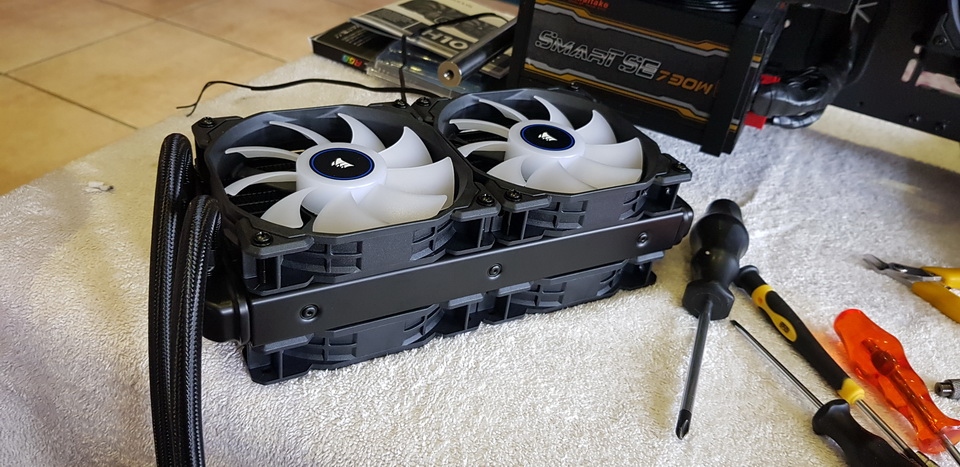 |
For this PC I selected the Corsair H100 - 240mm All-In-One water cooler.
Again I fitted two additional fans to create a push-pull configuration.
This increases air flow over the radiator producing more efficient cooling.
It also protects the delicate radiator fins.
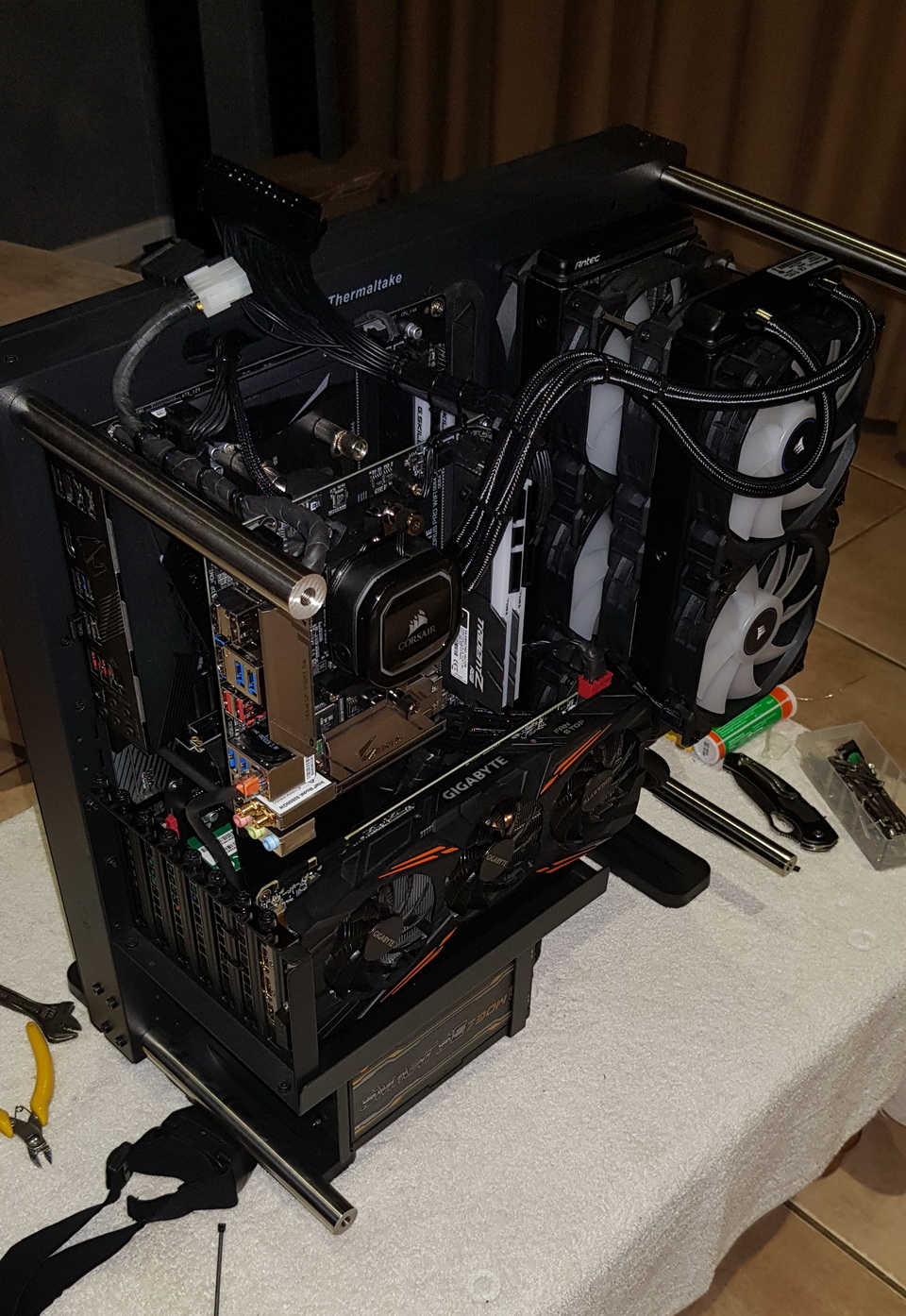 |
The build approaches completion.
Just the Power Supply to go.
 |
Installation |  |
The PC is now taken upstairs to my computer room.
There it is mounted to the wall to receive finishing touches.
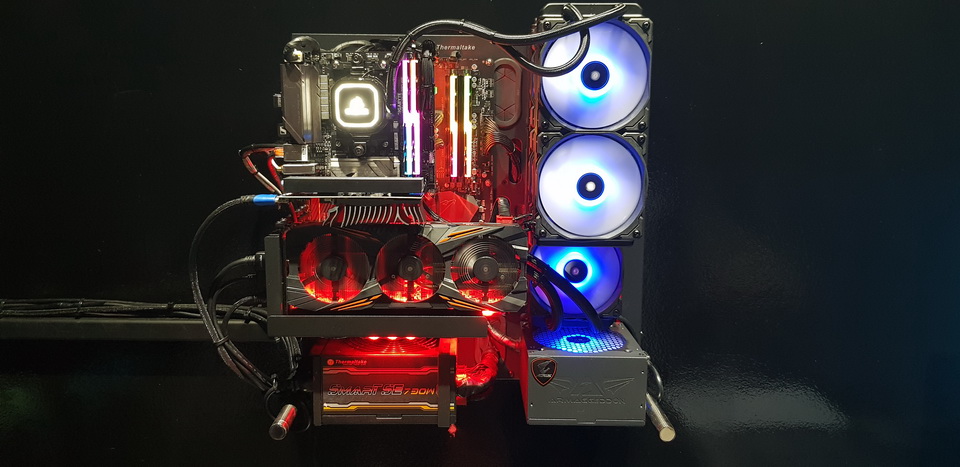 |
Now with the second power supply in place, the PC is hung on its bracket.
Neatly silhouetted against the black wall.
Monitor, power, network and USB cables are attached.
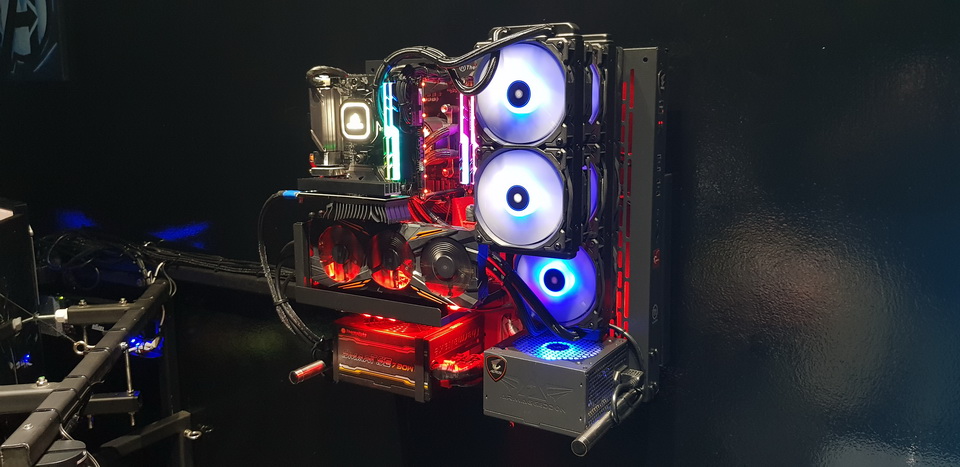 |
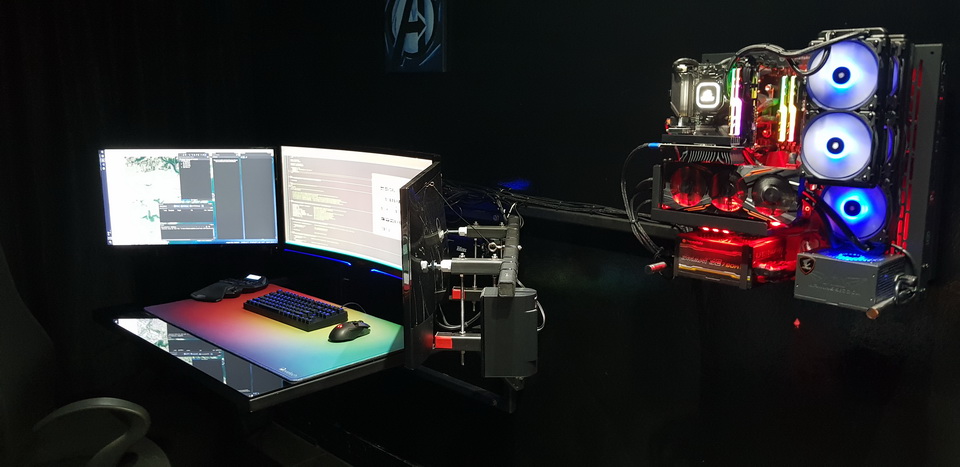 |
The mounting is an extension of the desk structure.
This provides a neat installation with no hanging cables and no wasted floor space.
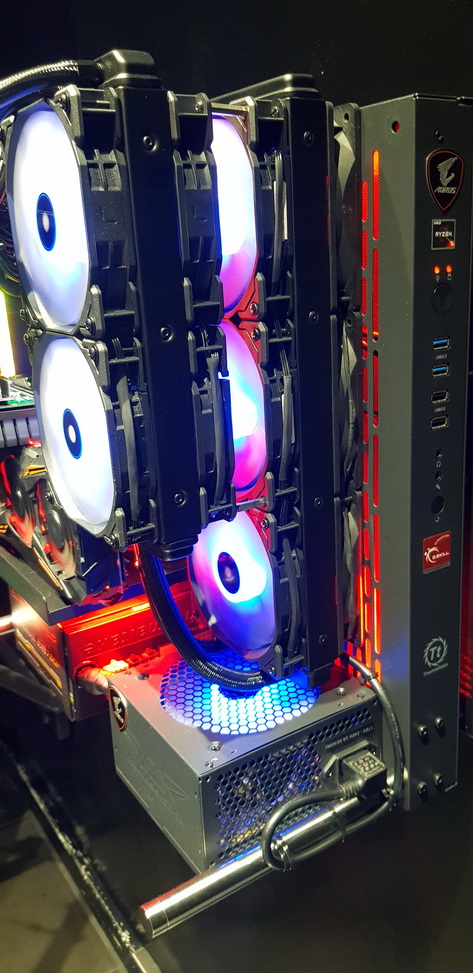 |
 |
Then there is the water cooling - a very important part of the build.
Each PC has its own radiator.
Each radiator has a double set of static pressure fans laid out in a push pull configuration.
Some ask if this extreme CPU cooling is necessary when the manufacturer supplies a simple air cooler with the CPU.
The simple answer is yes, if you want to drive your CPU hard for extended periods of time.
CPUs have what is called a Boost Frequency.
It allows the CPU to overclock to about 10% faster than its stock speed.
The problem is that this causes the CPU to heat up.
The PC monitors this temperature and will only allow the CPU to boost if the temperature is low.
So by having a ridiculous cooling system, this boost clock speed remains available to you.
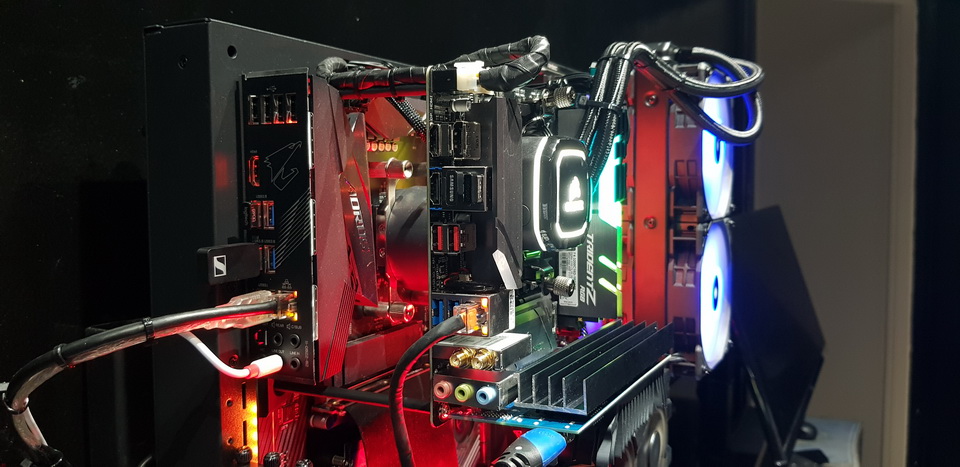 |
From this angle we see the Mini ITX B450 board mounted above the larger and
more powerful ATX X570 board.
Both Gigabyte motherboards. Both from the premium Aorus range.
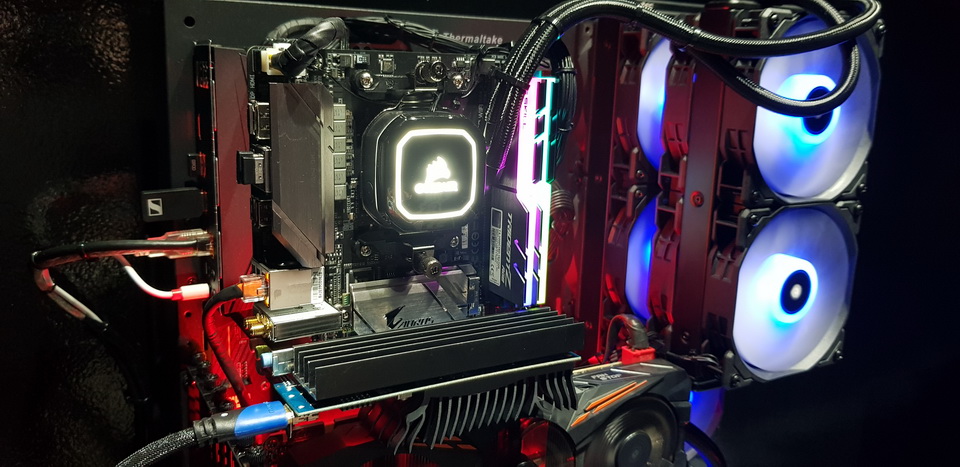 |
The additional Mini ITX PC looks beautifully menacing.
It provides me with an additional 12 processing threads with which to crunch numbers and run software.
It also allows me to process calculations while freeing my PC up for more leisurely tasks - like gaming.
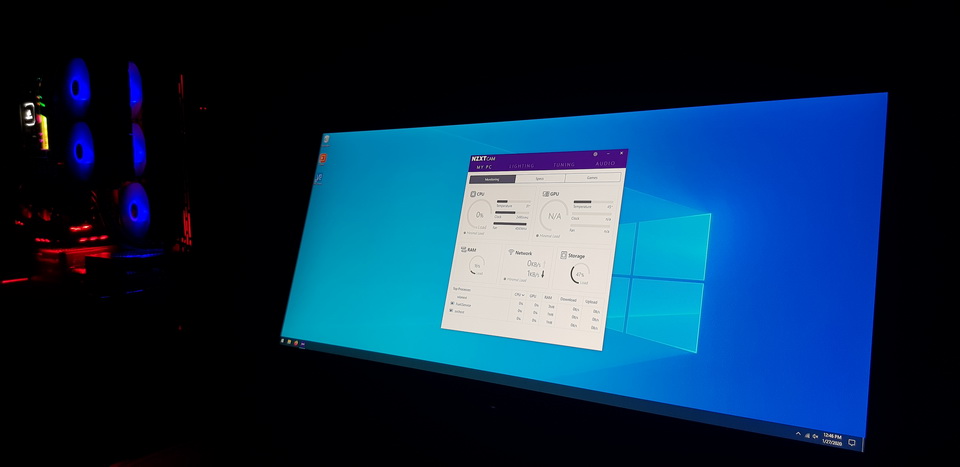 |
Although I will interact with the ITX PC primarily via VNC, it does have its own monitor keyboard and mouse for standalone operation.
That monitor being the LG 34 inch Ultra-wide, sporting a 2540 X 1080 resolution.
 |
THE DESK |  |
Then there is the desk itself.
Not to be understated in any way.
It would be a shame to have an exceptional PC but fail to create a pleasing workspace
in which to use it.
Let’s look at the monitor.
Black Friday came around as it does every November.
As my friend Gary Swartz and I looked around for the best tech deals, I found this gem.
The AGON AG352UCG6 Monitor manufactured by AOC
This 35 Inch Ultra-wide curved monitor sports a resolution of 3440 X 1440
with a refresh rate of 120 Hertz.
It also includes G-Sync for Nvidia Gamers
I was initially concerned about buying a brand with which I was not familiar,
but the R9000 discount was too good to turn down.
I have since learned a little about AOC. They manufacture high end monitors aimed at the gaming industry.
After a few months of use for gaming as well as productivity I can wholeheartedly endorse this monitor.
What a remarkable piece of high performance tech.
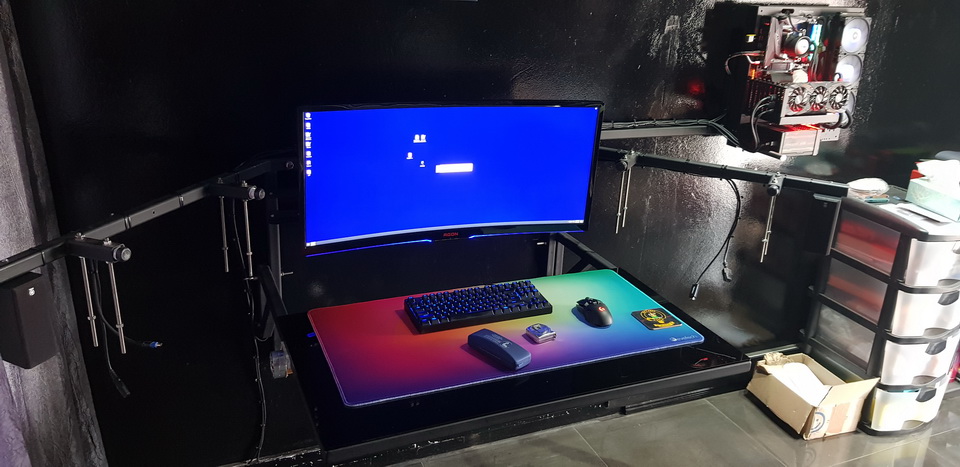 |
The installation was very simple as it replaced my LG 34 Inch Ultra-wide - which is similar in size.
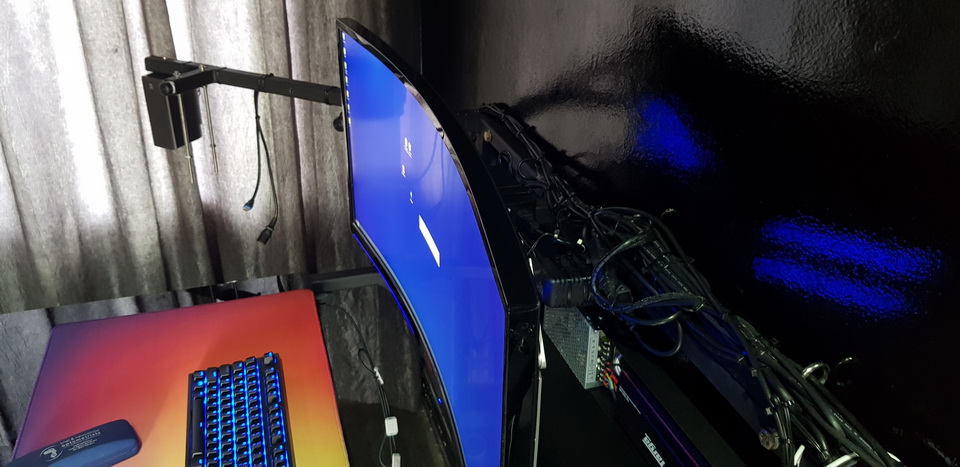 |
The monitor sports an aggressive curve with an 1800mm radius.
At first I was concerned that a curved monitor was a gimmick that came with a high price,
but after spending some time using it I have found that when it comes to wide PC monitors
it is a must.
I barely notice the curve until I sit in front of a flat monitor. Big difference.
Adding Sound.
I have never concerned myself with desk speakers.
I always used headphones - more on that later.
But I decided that now would be a good time to add a bit of quality audio to my build.
Especially considering that I had a set of high end Yamaha speakers wasting in my cupboard.
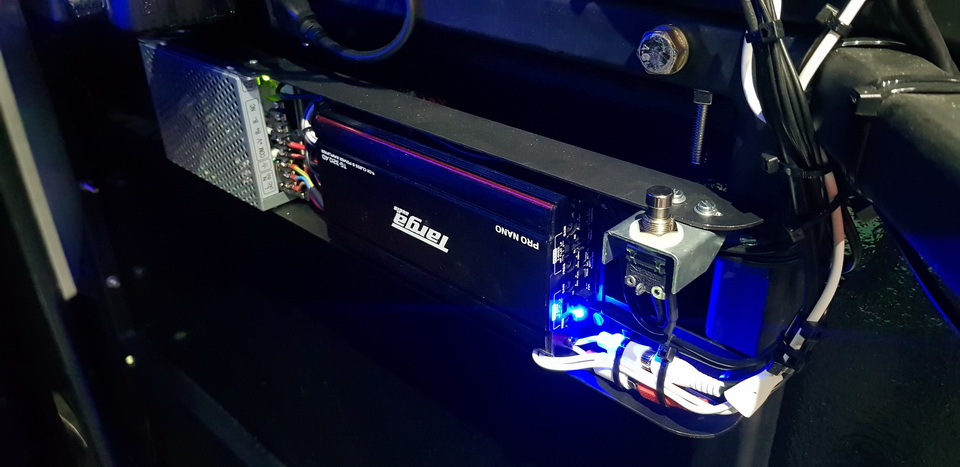 |
Finding a simple stereo slave amplifier proved surprisingly difficult.
I ended up getting a car amplifier which produces high quality powerful audio.
I added some aluminum angle iron to the desk to mount the amplifier behind the main monitor.
The downside of using a car amplifier is that it has to run on 12 Volts - Hence the power supply.
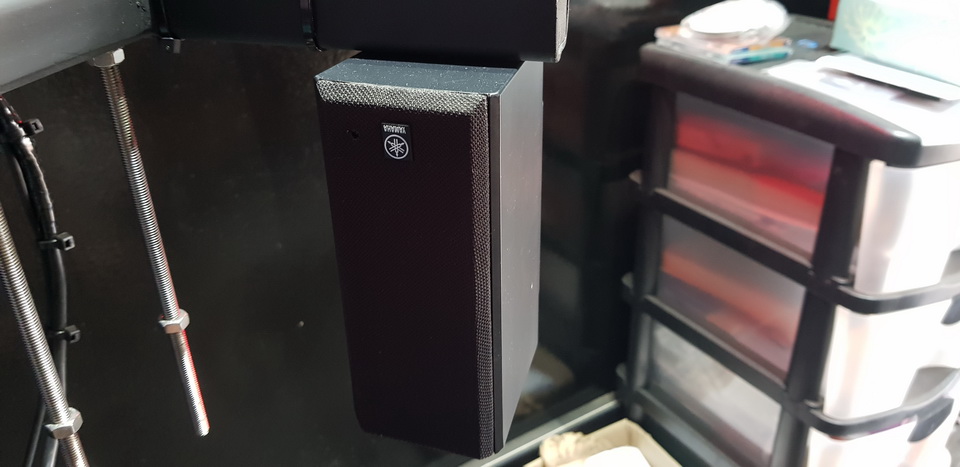 |
For my speakers I made use of a set of Yamaha speakers that I had left over from a previous project.
Powerful refined audio in a tiny package. Very pleasing to listen to indeed.
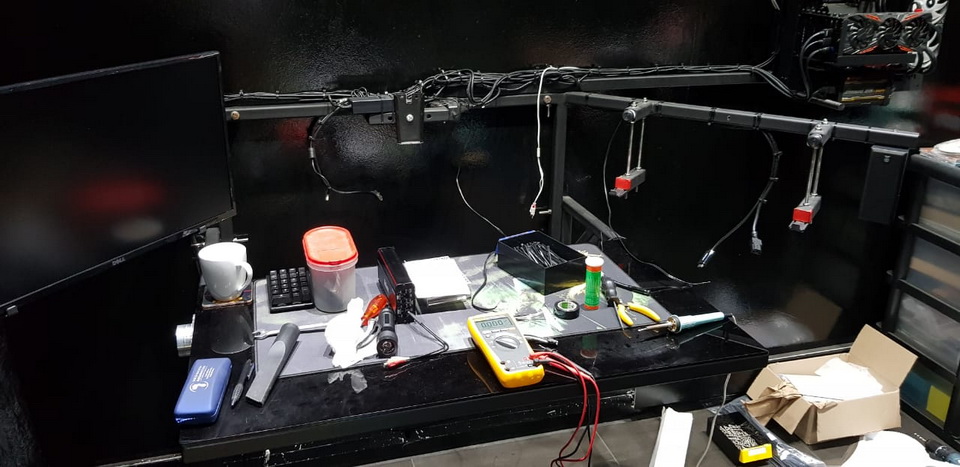 |
The installation of the amp and speakers involved more disassembly than I had expected.
A Word on the Peripherals.
A quick word on the peripherals.
They make up a large part of
the user experience, warranting a mention on this page.
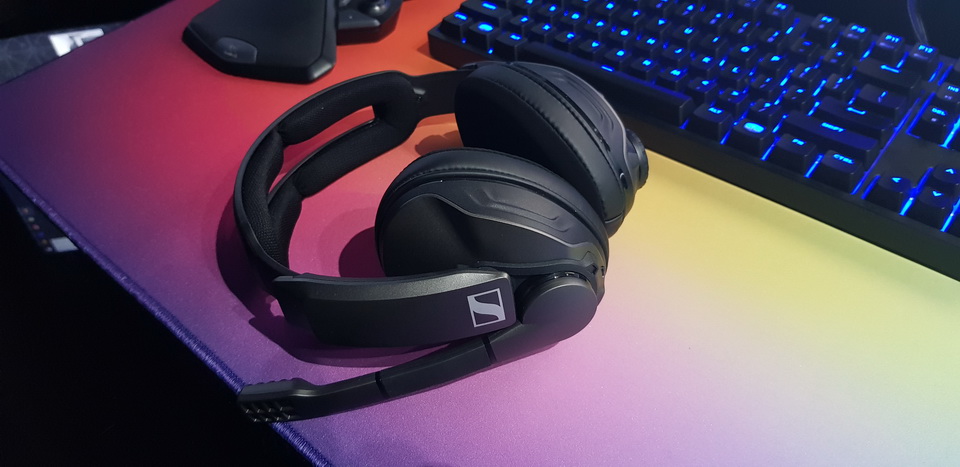 |
I always said that if Sennheiser ever made a wireless headset with a boom mic, I would buy it.
Now they have - so I did.
I purchased the GSP 370 from Sennheiser's new range of gaming headsets.
This is one of the most premium peripherals I have ever bought. 5 Stars in my book.
For those not familiar with Sennheiser, they are long standing world leaders in premium headphones.
Primarily directed at the high end audio market, they have now cut themselves a piece of the Gaming Industry pie.
If you cannot afford the premium price attached to these headphones, I can strongly recommend the Void Headphones made by Corsair. Perfect for gaming.
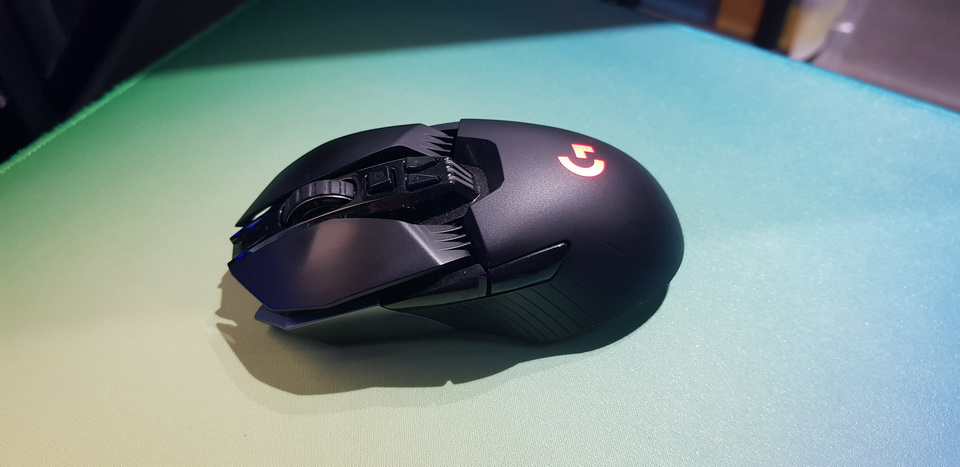 |
While not a new piece of equipment, I would like to mention my Logitech G900 gaming mouse.
This was the first mouse to include Logitech's "sub 1 ms" wireless interface.
It is a marvel of technological ingenuity - the Bugatti Veyron of its industry.
If you are looking to buy a quality gaming mouse at a more realistic price, I recommend the
Logitech G502 wireless.
Much of the technology perfected for this mouse has now filtered down to the G502.
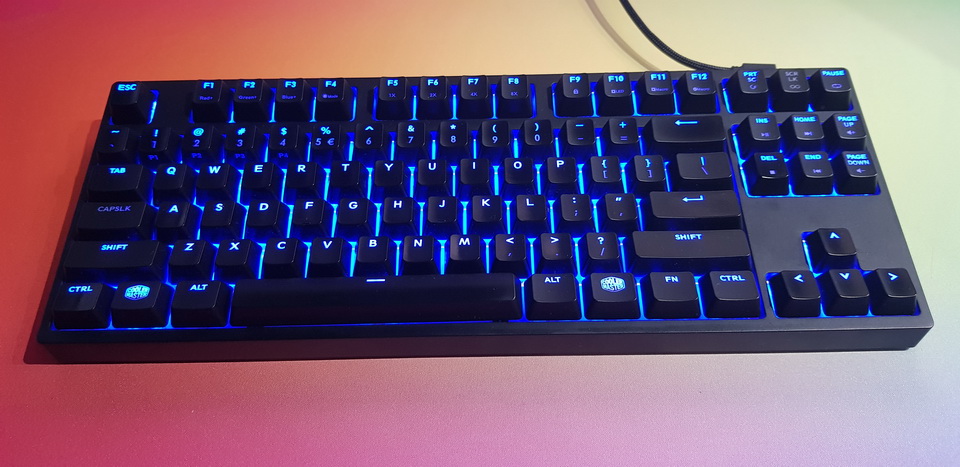 |
One last existing peripheral.
The Cooler Master - Master Keys Pro-S.
This premium keyboard sports the German made Cherry Blue mechanical keys.
It is certainly not the flashiest keyboard around today, but for those desiring a no-nonsense
keyboard for typing or productivity purposes,
that sports the highest build quality and is a pleasure to type on, I highly recommend it.
For those who insist on bling, it does offer individually controlled full range RGB on every key.
If you intend using it primarily for gaming, I recommend the Cherry Red version.
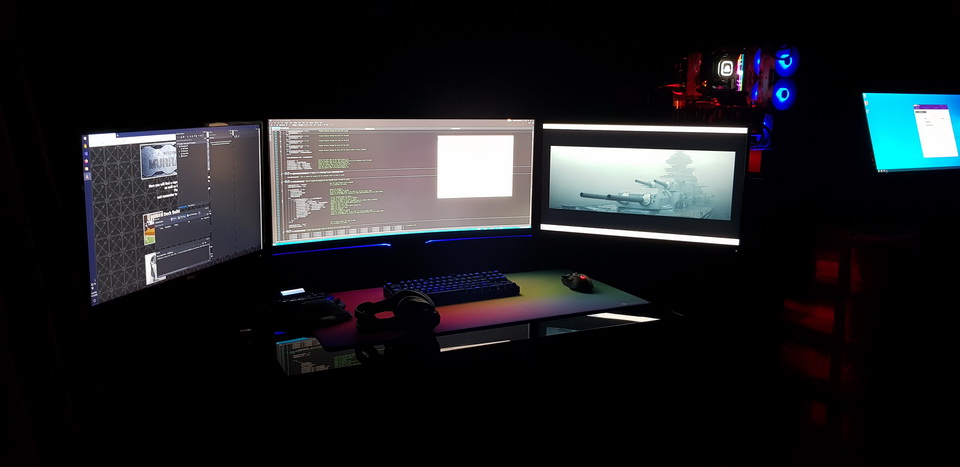 |
Well thats all there is to say at this point in time.
I am very pleased with the outcome of my recent works.
I now have a PC that looks like it was built at DARPA with reverse engineered technology from area 51.
Additionally I have a pleasing and productive workspace in which to conduct my
numerous technological affairs.
Thank you for visiting my 2020 Upgrade Page.
I hope you found something of interest.
Please come back soon to see what's new.
